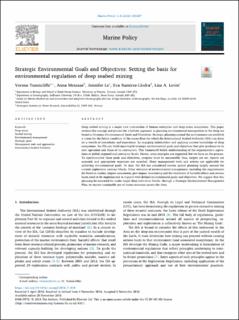| dc.contributor.author | Tunnicliffe, Verena | |
| dc.contributor.author | Metxas, Ana | |
| dc.contributor.author | Le, Jennifer | |
| dc.contributor.author | Ramirez-Llodra, Eva | |
| dc.contributor.author | Levin, Lisa A | |
| dc.date.accessioned | 2020-06-25T11:56:22Z | |
| dc.date.available | 2020-06-25T11:56:22Z | |
| dc.date.created | 2019-03-06T08:38:24Z | |
| dc.date.issued | 2020 | |
| dc.identifier.citation | Marine Policy. 2020, 114, 103347. | en_US |
| dc.identifier.issn | 0308-597X | |
| dc.identifier.uri | https://hdl.handle.net/11250/2659552 | |
| dc.description.abstract | Deep seabed mining is a major new intersection of human enterprise and deep-ocean ecosystems. This paper reviews the concept and process for a holistic approach to planning environmental management in the deep sea based on Strategic Environmental Goals and Objectives. Strategic planning around the environment can establish a vision for the future condition of the ocean floor for which the International Seabed Authority (ISA) can draw on a wealth of precedents and experience. By engaging stakeholders and applying current knowledge of deep ecosystems, the ISA can build meaningful strategic environmental goals and objectives that give guidance to its own operation and those of its contractors. This framework builds understanding of the organization’s aspirations at global, regional and contractor levels. Herein, some examples are suggested, but we focus on the process. To operationalize these goals and objectives, progress must be measurable; thus, targets are set, reports are assessed, and appropriate responses are awarded. Many management tools and actions are applicable for achieving environmental goals. To date, the ISA has considered marine spatial planning largely around the current exploration contract blocks. Other elements of environmental management, including the requirements for baseline studies, impact assessment, post-impact monitoring and the treatment of harmful effects and serious harm need to be implemented to support well-defined environmental goals and objectives. We suggest that this planning be executed for scales larger than individual blocks, through a Strategic Environmental Management Plan, to ensure sustainable use of ocean resources across the Area. | en_US |
| dc.language.iso | eng | en_US |
| dc.publisher | Elsevier | en_US |
| dc.rights | Attribution-NonCommercial-NoDerivatives 4.0 Internasjonal | * |
| dc.rights.uri | http://creativecommons.org/licenses/by-nc-nd/4.0/deed.no | * |
| dc.title | Strategic Environmental Goals and Objectives: Setting the basis for environmental regulation of deep seabed mining | en_US |
| dc.type | Peer reviewed | en_US |
| dc.type | Journal article | en_US |
| dc.description.version | publishedVersion | en_US |
| dc.rights.holder | © 2018 The Authors | en_US |
| dc.source.pagenumber | 10 | en_US |
| dc.source.volume | 114 | en_US |
| dc.source.journal | Marine Policy | en_US |
| dc.identifier.doi | 10.1016/j.marpol.2018.11.010 | |
| dc.identifier.cristin | 1682522 | |
| dc.relation.project | Norges forskningsråd: 247626 | en_US |
| cristin.ispublished | true | |
| cristin.fulltext | original | |
| cristin.fulltext | original | |
| cristin.qualitycode | 1 | |

